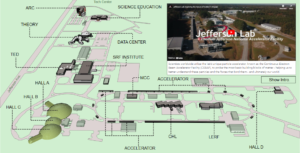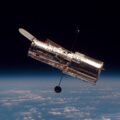The U.S. Department of Energy’s (DOE) Thomas Jefferson National Accelerator Facility has released a new interactive map that allows curious visitors the ability to take a virtual tour of the facility from the comfort of their own homes.
Simple to use and understand and packed with stunning details about the works at the facility, the new video tour released by the Jefferson Lab allows for unprecedented, behind-the-scenes access to one of the DOE’s most advanced and, up until now, most inaccessible research facilities in the world.
DOE Facility is “Probing the Building Blocks of Matter”
For those not versed in particle physics, facilities like National Accelerator Facility and the Large Hadron Collider in Switzerland slam electrons together at near-light speed to help researchers understand the quantum components that make up all matter. For example, these types of experiments helped peel back the mystery behind mass with the discovery of the Higgs boson in 2012. Now, they are hoping to illuminate the understanding of things like gravity and dark matter.
According to the facility’s website: “Scientists worldwide utilize the lab’s unique particle accelerator, known as the Continuous Electron Beam Accelerator Facility (CEBAF), to probe the most basic building blocks of matter – helping us to better understand these particles and the forces that bind them – and ultimately our world.”


The map itself highlights fifteen unique sections of the campus in total, including videos and still shots of a number of the primary facilities. This includes the aforementioned CEBAF, as well as a close-up look at the Superconducting Radiofrequency (SRF) accelerator. According to the Jefferson Lab website, “particle accelerators built with SRF technology deliver a continuous beam of particles with improved beam quality and lower energy consumption.”
Over 1,850 Scientists Worldwide Contribute to research at the National Accelerator Facility
The tour also includes a closer look at the Center for Theoretical and Computational Physics. Alongside the work of the particle accelerator, the CTCP “pursues a broad program of theoretical research in all areas of quantum chromodynamics (QCD) and hadron physics, promoting and supporting the physics studied at Jefferson Lab and related facilities around the world.”
So, if you want to see the huge, 450-ton high-resolution spectrometers hanging out in Hall A, the 12 GeV CEBAF Large Acceptance Spectrometer in Hall B used to track and measure subatomic particles, or two of the world’s largest superfluid helium refrigerators housed in the rarely accessible Central Helium Liquefier, systems that the researchers claim can “create temperatures colder than the vast reaches of outer space,” this is your chance!
And unlike the over 1,850 scientists from around the world who work on research projects at the National Accelerator Facility, you can take the tour from your own home instead of traveling all the way to Newport News, Virginia.
Christopher Plain is a Science Fiction and Fantasy novelist and Head Science Writer at The Debrief. Follow and connect with him on Twitter, learn about his books at plainfiction.com, or email him directly at christopher@thedebrief.org.

